The Flexible Metallic Conduit Market is estimated to be valued at USD 580.6 million in 2025 and is projected to reach USD 1163.6 million by 2035, registering a compound annual growth rate (CAGR) of 7.2% over the forecast period. This steady growth trajectory indicates a market where cost optimization and supply chain efficiency remain central to competitive advantage, and raw material sourcing, manufacturing processes, and distribution channels heavily influence the cost structure. A significant portion of production costs is linked to high-grade metals, particularly steel and aluminum, which form the primary input for conduits. Fluctuations in metal prices directly affect manufacturing margins, making procurement strategies critical within the value chain. Labor and operational expenditures constitute another substantial share, particularly for manufacturing units that maintain high precision and durability standards to meet electrical safety regulations. The value chain further involves specialized processing steps, including corrugation, annealing, and coating, which enhance mechanical flexibility and corrosion resistance.
Distribution and logistics represent another cost layer, especially for markets that demand timely delivery to construction, residential, and industrial projects. Retail and wholesale margins also contribute to end-market pricing, influencing adoption rates in cost-sensitive segments. Over the forecast period, efficiency improvements, automation in manufacturing, and strategic sourcing are expected to optimize costs, ensuring that the market maintains profitability while accommodating rising demand for safety-compliant and durable flexible metallic conduit solutions.
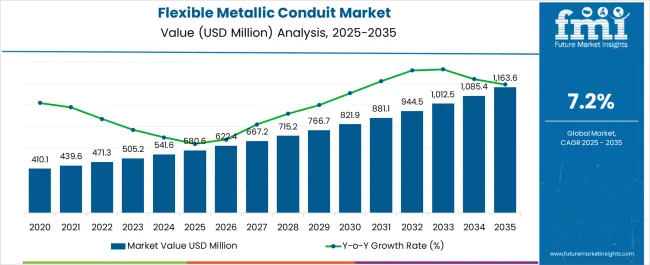
| Metric | Value |
|---|---|
| Flexible Metallic Conduit Market Estimated Value in (2025 E) | USD 580.6 million |
| Flexible Metallic Conduit Market Forecast Value in (2035 F) | USD 1163.6 million |
| Forecast CAGR (2025 to 2035) | 7.2% |
The flexible metallic conduit market is experiencing sustained growth driven by rising demand for advanced electrical protection systems across construction, infrastructure, and transportation sectors. Increased emphasis on durability, fire resistance, and EMI shielding has positioned flexible metallic conduits as a preferred choice in both retrofitting and new installations.
Technological advancements in conduit coatings and corrosion-resistant materials are further supporting deployment in challenging environments. Urbanization and infrastructure upgrades in emerging economies are expanding the scope of application, while regulatory standards on fire safety and electrical integrity continue to reinforce adoption.
The future outlook remains optimistic as stakeholders prioritize flexibility, safety, and reliability in electrical infrastructure development across residential, commercial, and industrial domains.
The flexible metallic conduit market is segmented by trade size, application, end use, and geographic regions. By trade size, the flexible metallic conduit market is divided into ½ to 1, 1¼ to 2, 2½ to 3, 3 to 4, 5 to 6, and Others. In terms of application, the flexible metallic conduit market is classified into Rail infrastructure, Military Aerospace, Healthcare Facilities, Process Plants, Energy, and Others.
Based on end use, the flexible metallic conduit market is segmented into Residential, Commercial, Industrial, and Utility. Regionally, the flexible metallic conduit industry is classified into North America, Latin America, Western Europe, Eastern Europe, Balkan & Baltic Countries, Russia & Belarus, Central Asia, East Asia, South Asia & Pacific, and the Middle East & Africa.
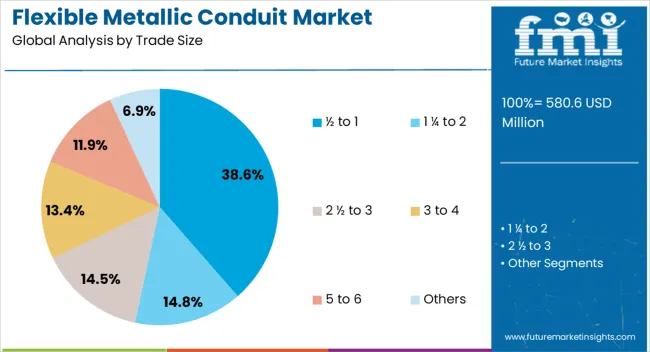
The ½ to 1 trade size segment is expected to contribute 38.60% of total market revenue by 2025, emerging as the dominant range within the trade size category. This preference is attributed to its widespread compatibility with standard wiring systems and its efficiency in supporting medium-capacity electrical loads.
Its adaptability across residential and light commercial installations enhances its utility. Furthermore, the manageable diameter offers installation flexibility in tight spaces, conduits, and wall cavities.
Contractors and electricians prefer this range due to its ease of handling, reduced material cost, and regulatory compliance in mainstream construction codes. These combined functional and operational advantages have made this trade size the most commonly used across diverse electrical projects.
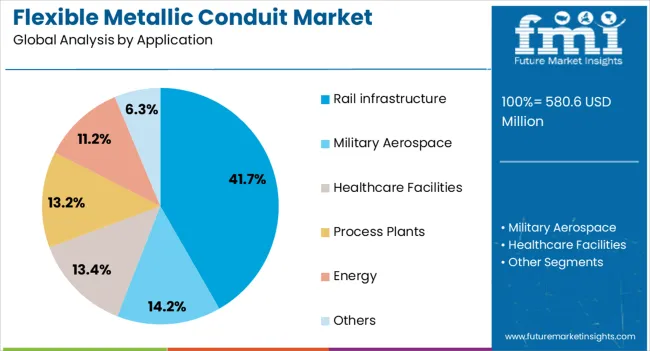
The rail infrastructure segment is projected to hold 41.70% of the market by 2025, making it the leading application within the flexible metallic conduit market. Growing investments in metro systems, high-speed rail, and electrified transport corridors drive the segment’s dominance.
Flexible metallic conduits are being increasingly utilized to protect cabling systems in harsh environments typical of rail applications, including vibration, temperature fluctuations, and electromagnetic interference. National infrastructure development programs and smart mobility initiatives are further pushing demand for advanced conduit systems to ensure uninterrupted power supply and safety compliance.
The need for long-term durability and easy retrofitting options has also strengthened the use of flexible metallic conduits in this segment.
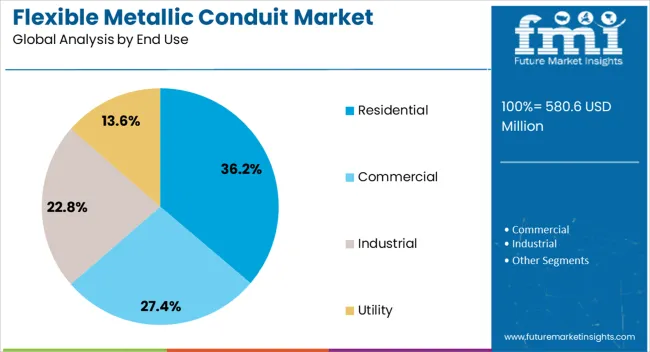
The residential end use segment is anticipated to contribute 36.20% of total revenue by 2025, leading among end users in the market. This growth is being supported by rapid urban housing developments, home automation adoption, and increasing focus on fire-safe electrical installations.
Homeowners and developers are opting for flexible metallic conduits for concealed wiring, as they offer enhanced protection, ease of routing, and longevity. Regulatory updates regarding residential electrical safety and energy efficiency are further encouraging the use of metallic conduit systems.
The segment also benefits from a growing preference for durable wiring solutions in high-rise apartments, gated communities, and smart home projects.
The market has been expanding due to its widespread use in electrical wiring systems across residential, commercial, and industrial sectors. These conduits have been valued for their durability, flexibility, and ability to provide mechanical protection to cables while facilitating easy installation in complex routing environments. The market has been influenced by rising construction activities, increasing demand for robust electrical infrastructure, and regulatory requirements for safety and fire protection. Enhanced corrosion resistance and compatibility with modern wiring systems have further strengthened adoption globally.
The market has been significantly influenced by construction and infrastructure projects. Residential and commercial buildings have widely employed these conduits to ensure reliable electrical wiring protection, particularly in high-traffic or vibration-prone areas. Industrial facilities, including manufacturing plants and processing units, have used conduits to protect electrical networks from mechanical damage, moisture, and chemical exposure. Growing investments in urban development, industrial parks, and smart buildings have further expanded demand. Conduits have been preferred for retrofitting older structures as well, due to their flexibility and ease of installation. As a result, large-scale construction projects have become primary drivers of market growth, providing both short-term and long-term opportunities for manufacturers.
Technological advancements have reinforced the adoption of flexible metallic conduits by improving performance, durability, and ease of installation. Conduits with enhanced corrosion resistance, anti-crush designs, and lightweight alloys have allowed longer service life and reduced maintenance requirements. Integration with cable management systems and compatibility with advanced wiring solutions, such as high-voltage and fiber optic cables, have expanded application potential. Innovations in coupling systems and protective coatings have increased resistance to environmental stressors, including moisture, chemicals, and temperature variations. These technological improvements have strengthened the value proposition of flexible metallic conduits over non-metallic alternatives in both industrial and commercial settings.
The market has been shaped by stringent regulatory standards and safety codes for electrical installations. Compliance with national and international standards for fire resistance, grounding, and mechanical protection has ensured reliable and safe electrical systems. Local regulations have mandated the use of metallic conduits in high-risk zones, such as industrial facilities, healthcare centers, and public infrastructure. Certification and quality assurance programs have further reinforced adoption by confirming material strength and installation integrity. These standards have encouraged building designers, electrical contractors, and facility managers to prefer flexible metallic conduits over alternative options, driving consistent demand across diverse construction and industrial segments.
Despite strong demand, the flexible metallic conduit market has faced challenges from cost pressures and fluctuations in raw material prices. Steel and aluminum, which constitute primary materials, have experienced volatility in global markets, impacting production costs. Competition from non-metallic conduits, which are lighter and cheaper, has also influenced adoption in cost-sensitive projects. Suppliers have had to balance performance requirements with pricing constraints, particularly in large-scale construction and industrial applications. To maintain market share, manufacturers have focused on product differentiation through enhanced durability, flexibility, and corrosion resistance while exploring alternate alloys and efficient production techniques to reduce dependency on fluctuating raw material prices.

| Countries | CAGR |
|---|---|
| China | 9.7% |
| India | 9.0% |
| Germany | 8.3% |
| France | 7.6% |
| UK | 6.8% |
| USA | 6.1% |
| Brazil | 5.4% |
The market is projected to grow at a CAGR of 7.2% between 2025 and 2035, driven by rising demand for durable electrical infrastructure and industrial safety compliance. China leads with a 9.7% CAGR, supported by large-scale construction projects and robust industrial growth. India follows at 9.0%, propelled by expanding electrical installations and modernization of industrial facilities. Germany, at 8.3%, benefits from advanced manufacturing and stringent safety standards. The UK, growing at 6.8%, focuses on industrial and commercial electrical applications, while the USA, at 6.1%, sees steady adoption across construction and energy sectors. This report includes insights on 40+ countries; the top markets are shown here for reference.
China is projected to grow at a CAGR of 9.7% over the forecast period, driven by rapid industrial expansion and large-scale infrastructure development. Rising urban construction activities and modernization of electrical systems are increasing the need for flexible metallic conduits for safe and durable wiring. Adoption of advanced conduit materials for enhanced fire resistance and mechanical strength is supporting demand. The domestic manufacturing sector is expanding to cater to regional and export requirements. Government initiatives focusing on electrical safety compliance and energy efficiency are also promoting the integration of flexible metallic conduits in industrial, commercial, and residential projects.
India is expected to register a CAGR of 9.0%, fueled by rising construction of industrial parks, commercial buildings, and power plants. Stringent electrical safety standards and regulations encourage the use of flexible metallic conduits in wiring installations. Adoption of advanced conduit designs for corrosion resistance and fire safety is gaining traction. Local manufacturers are scaling production capacities to meet both domestic and regional demand. Urban and semi-urban infrastructure projects, along with increased electricity distribution networks, are contributing to market growth.
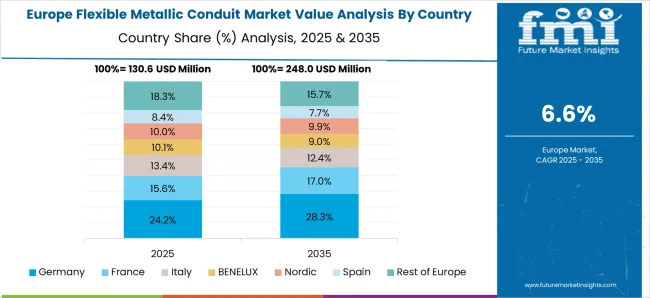
Germany is forecasted to expand at a CAGR of 8.3%, driven by industrial automation, manufacturing, and construction activities. The replacement of aging electrical systems with durable and high-performance metallic conduits is accelerating market adoption. Conduits with superior corrosion resistance and mechanical stability are preferred in both industrial and commercial applications. German manufacturers focus on innovation, offering premium-quality metallic conduits that comply with strict European safety and performance standards. The growing trend of retrofitting older facilities with advanced electrical systems supports consistent demand.
The United Kingdom is projected to grow at a CAGR of 6.8% due to increasing adoption in commercial and residential construction projects. Implementation of stringent electrical safety regulations is driving demand for metallic conduits, particularly for fire-resistant and durable installations. Infrastructure modernization, including energy-efficient electrical systems, is further supporting market growth. Suppliers are focusing on offering certified, high-quality conduits to meet performance standards, while government-driven projects in public buildings contribute to consistent demand.
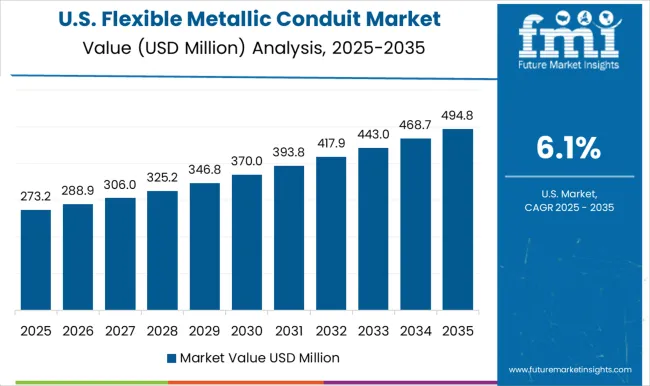
The United States is expected to register a CAGR of 6.1%. Growth is driven by the expansion of industrial facilities, residential construction, and upgrades to existing electrical infrastructure. Compliance with national electrical safety codes encourages the use of flexible metallic conduits. Manufacturers are investing in innovative materials, corrosion-resistant finishes, and improved mechanical performance to meet market demands. Industrial automation projects and modernization of residential wiring systems are key factors supporting market expansion.
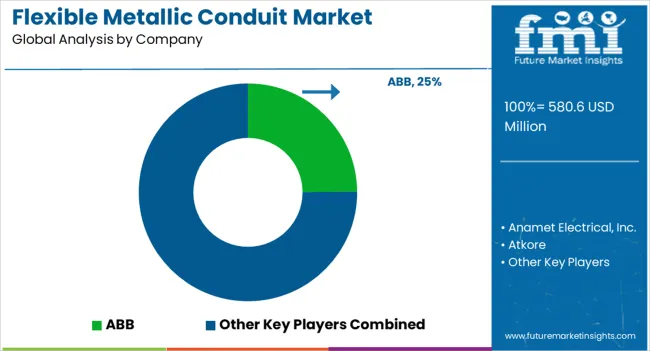
The market is experiencing steady growth driven by rising industrial automation, construction activities, and the need for reliable electrical wiring protection. ABB and Atkore are at the forefront, offering high-quality metallic conduits that provide mechanical protection and flexibility for complex electrical installations. Anamet Electrical, Inc., and Electri-Flex Company contribute through durable, corrosion-resistant solutions suitable for both industrial and commercial applications, ensuring safety and compliance with regulatory standards.
HellermannTyton and Kaiphone Technology Co., Ltd. focus on innovative designs that simplify installation while maintaining robust performance under varying environmental conditions. Dongguan FlexGlory Machinery Accessories Co., Ltd., Shanghai Weyer Electric Co., Ltd., and Southwire Company, LLC. deliver cost-effective and versatile conduit systems tailored for large-scale infrastructure projects. Bahra Electric, International Metal Hose Company, United Power, and Whitehouse Flexible Tubing strengthen the market by providing specialized conduits for high-temperature, high-voltage, and harsh environment applications. The collective efforts of these providers emphasize durability, ease of installation, and adaptability to modern electrical networks. Continuous innovation and adherence to industry standards allow these companies to maintain leadership while supporting safer, more efficient electrical infrastructure development globally.
| Item | Value |
|---|---|
| Quantitative Units | USD 580.6 Million |
| Trade Size | ½ to 1, 1 ¼ to 2, 2 ½ to 3, 3 to 4, 5 to 6, and Others |
| Application | Rail infrastructure, Military Aerospace, Healthcare Facilities, Process Plants, Energy, and Others |
| End Use | Residential, Commercial, Industrial, and Utility |
| Regions Covered | North America, Europe, Asia-Pacific, Latin America, Middle East & Africa |
| Country Covered | United States, Canada, Germany, France, United Kingdom, China, Japan, India, Brazil, South Africa |
| Key Companies Profiled | ABB, Anamet Electrical, Inc., Atkore, Bahra Electric, Dongguan FlexGlory Machinery Accessories Co., Ltd., Electri-Flex Company, HellermannTyton, International Metal Hose Company, Kaiphone Technology Co. Ltd., Shanghai Weyer Electric Co., Ltd., Southwire Company, LLC., United Power, and Whitehouse Flexible Tubing |
| Additional Attributes | Dollar sales by conduit type and application, demand dynamics across construction, industrial, and commercial sectors, regional trends in electrical infrastructure development, innovation in corrosion resistance and flexibility, environmental impact of material sourcing and disposal, and emerging use cases in smart buildings and industrial automation. |
The global flexible metallic conduit market is estimated to be valued at USD 580.6 million in 2025.
The market size for the flexible metallic conduit market is projected to reach USD 1,163.6 million by 2035.
The flexible metallic conduit market is expected to grow at a 7.2% CAGR between 2025 and 2035.
The key product types in flexible metallic conduit market are ½ to 1, 1 ¼ to 2, 2 ½ to 3, 3 to 4, 5 to 6 and others.
In terms of application, rail infrastructure segment to command 41.7% share in the flexible metallic conduit market in 2025.






Our Research Products

The "Full Research Suite" delivers actionable market intel, deep dives on markets or technologies, so clients act faster, cut risk, and unlock growth.

The Leaderboard benchmarks and ranks top vendors, classifying them as Established Leaders, Leading Challengers, or Disruptors & Challengers.

Locates where complements amplify value and substitutes erode it, forecasting net impact by horizon

We deliver granular, decision-grade intel: market sizing, 5-year forecasts, pricing, adoption, usage, revenue, and operational KPIs—plus competitor tracking, regulation, and value chains—across 60 countries broadly.

Spot the shifts before they hit your P&L. We track inflection points, adoption curves, pricing moves, and ecosystem plays to show where demand is heading, why it is changing, and what to do next across high-growth markets and disruptive tech

Real-time reads of user behavior. We track shifting priorities, perceptions of today’s and next-gen services, and provider experience, then pace how fast tech moves from trial to adoption, blending buyer, consumer, and channel inputs with social signals (#WhySwitch, #UX).

Partner with our analyst team to build a custom report designed around your business priorities. From analysing market trends to assessing competitors or crafting bespoke datasets, we tailor insights to your needs.
Supplier Intelligence
Discovery & Profiling
Capacity & Footprint
Performance & Risk
Compliance & Governance
Commercial Readiness
Who Supplies Whom
Scorecards & Shortlists
Playbooks & Docs
Category Intelligence
Definition & Scope
Demand & Use Cases
Cost Drivers
Market Structure
Supply Chain Map
Trade & Policy
Operating Norms
Deliverables
Buyer Intelligence
Account Basics
Spend & Scope
Procurement Model
Vendor Requirements
Terms & Policies
Entry Strategy
Pain Points & Triggers
Outputs
Pricing Analysis
Benchmarks
Trends
Should-Cost
Indexation
Landed Cost
Commercial Terms
Deliverables
Brand Analysis
Positioning & Value Prop
Share & Presence
Customer Evidence
Go-to-Market
Digital & Reputation
Compliance & Trust
KPIs & Gaps
Outputs
Full Research Suite comprises of:
Market outlook & trends analysis
Interviews & case studies
Strategic recommendations
Vendor profiles & capabilities analysis
5-year forecasts
8 regions and 60+ country-level data splits
Market segment data splits
12 months of continuous data updates
DELIVERED AS:
PDF EXCEL ONLINE
Liquid-Tight Flexible Non-Metallic Conduit Market Size and Share Forecast Outlook 2025 to 2035
Commercial Liquid-Tight Flexible Non-Metallic Conduit Market Size and Share Forecast Outlook 2025 to 2035
Flexible Metallic Tubing Market Size and Share Forecast Outlook 2025 to 2035
Flexible Electrical Conduit Market Size and Share Forecast Outlook 2025 to 2035
Liquid-Tight Flexible Metal Conduit Market Size and Share Forecast Outlook 2025 to 2035
Commercial Flexible Electrical Conduit Market Size and Share Forecast Outlook 2025 to 2035
Utility-Scale Flexible Electrical Conduit Market Size and Share Forecast Outlook 2025 to 2035
Flexible Packaging Paper Market Size and Share Forecast Outlook 2025 to 2035
Flexible Plastic Pouch Market Size and Share Forecast Outlook 2025 to 2035
Metallic Stearate Market Size and Share Forecast Outlook 2025 to 2035
Metallic Labels Market Size and Share Forecast Outlook 2025 to 2035
Flexible Plastic Packaging Market Size and Share Forecast Outlook 2025 to 2035
Flexible Rubber Sheets Market Size and Share Forecast Outlook 2025 to 2035
Flexible Printed Circuit Boards Market Size and Share Forecast Outlook 2025 to 2035
Flexible Packaging Machinery Market Size and Share Forecast Outlook 2025 to 2035
Flexible Electronic Market Size and Share Forecast Outlook 2025 to 2035
Flexible Foam Market Size and Share Forecast Outlook 2025 to 2035
Flexible Plastic Packaging Industry Analysis in United States Size and Share Forecast Outlook 2025 to 2035
Flexible Protective Packaging Market Size and Share Forecast Outlook 2025 to 2035
Flexible AC Current Transmission System Market Size and Share Forecast Outlook 2025 to 2035

Thank you!
You will receive an email from our Business Development Manager. Please be sure to check your SPAM/JUNK folder too.
Chat With
MaRIA